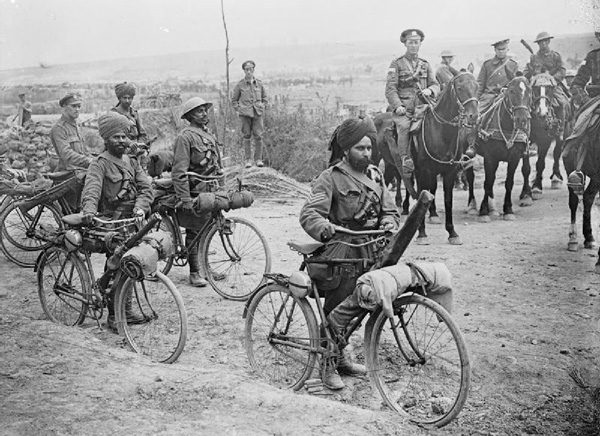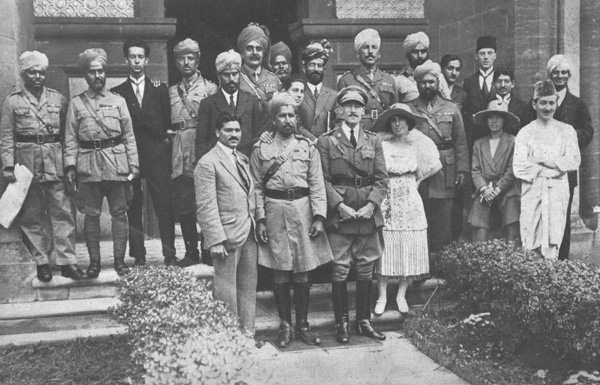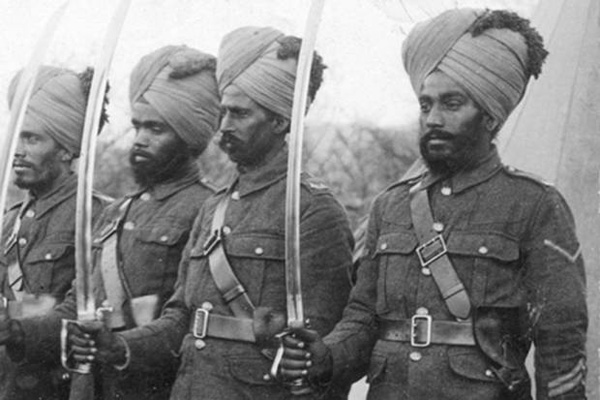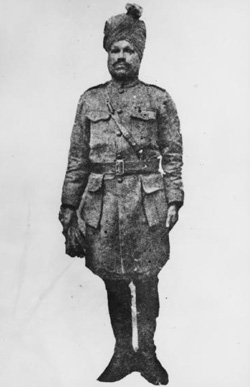Centenary of World War I: England honours World War I Indian heroes
Compiled by Dr. Eugene DSouza
Bellevision Media Network
04 Aug 2014: World War I began on 28 July 1914 when Austria declared war on Serbia, the Balkan country that was blamed by Austria being behind the assassination of the Austrian Archduke Francis Ferdinand and his Duchess at Sarajevo by the Bosnian youth Gavrilo Princip on 28 June 1914. Meanwhile, Russia mobilized her troops in support of Serbia with which the Russians had ethnic affinity as both Russians and Serbians like other Balkan people belonged to the Slavonic race. Germany, which was in alliance with Austria demanded that Russia should give up the mobilization of her troops in support of Serbia that was ignored by the latter following which Germany declared war on Russia on 1 August 1914. Germany also declared war on France on 3 August 1914. When the German army invaded Belgium on 4 August 1914, England declared war on Germany as Belgian neutrality was guaranteed by the European powers. Hence, major European powers got themselves entangled in the deadly conflict that came to be known as World War I that had far reaching consequences.

Indian bicycle troops at the Battle of the Somme

Indian Muslim soldiers at the Woking Mosque

Sikh Soldiers in World War I
4 August 2014 marked the centenary of the entry of England in World War. India being part of the British overseas empire was unwittingly drawn in World War I and was destined to play an important role as a large contingent of Indian soldiers actively participated in the war.
When World War I broke out in 1914, India was in a state of growing political unrest. The Indian National Congress had grown from an organization that simply discussed issues and pleaded for reforms into a body that was pushing for more self-government. Before the war started, the Germans had spent a great deal of time and energy trying to stir up an anti-British movement in India. Many shared the view that if Britain got involved in a crisis somewhere in the world, Indian separatists would use this as an opportunity to advance their cause.
However, these calculations were found to be erroneous. When war was declared on 4 August 1914, India rallied to the cause of Britain. Those with influence within India believed that the cause of Indian independence would best be served by helping out Britain in whatever capacity India couldThe Moderates in the Indian National Congress felt that they had more to gain through cooperation with the British in the war than opposition. It was assumed that Indian support during the war would be rewarded with substantial reforms after the end of the war. Mahatma Gandhi who had returned to India from South Africa also offered full cooperation to the British in their war efforts. As a goodwill gesture for Indian support, the British released Bala Gangadhar Tilak, who had been in prison since 1908 on charges of sedition.
Offers of financial and military help came from all over the country. The British also got support in terms of money and soldiers not only wealthy princes, but also from regions outside India such as Nepal that sent 100,000 Gurkhas and the Dalai Lama in Tibet offered 1000 of his troops to the cause. Despite the pre-war fears of unrest, Britain, in fact, could take many troops and most of her military equipment out of India as fears of unrest subsided. Indian troops were ready for battle before most other troops in the dominions.
Over a million Indian soldiers sided with Great Britain and fought the Great War alongside them. In fact Britain brought into the field a huge mass of colonial soldiers perhaps never seen in History until then. They were from India, Canada, New Zealand, Australia and South Africa. About 1.5 million Indian soldiers labored and fought war in places where otherwise they would have never dream going. Scattered in three continents they were supporting and clearing the road for victory, victory of course for their Imperial masters.The Indian army during World War I contributed a number of divisions and independent brigades to the European, Mediterranean and the Middle East theatres of war. Among the Indian troops who served along with allied forces overseas, 62,000 died and another 67,000 were wounded. In total 74,187 Indian soldiers died during the war.
BV.jpg)
Scottish and Indian soldiers in a trench
BV.jpg)
Indian Gunners in the battle of Jerusalem, 1917
BV.jpg)
Brigade Signal Station Dehra Dun Brigade
BV.jpg)
Two Indian soldiers undergoing electrical treatment in Kitchner Indian Hospital in Brighton. These treatment was used to stimulate the nerves of wounded soldiers
BV.jpg)
Indian Military Engineers in action in Mesopotamia (Iraq)
-BV.jpg)
Nurse and other medical staffs carry a wounded Indian soldier inside the truck
BV.jpg)
Indian soldiers in Mesopotamia shooting with a Lewis Gun
BV.jpg)
The I st battalion of the 4th Gurkhas lined up for kit inspection
In World War I, the Indian Army fought against the German Empire in German East Africa (modern Tanganyika) and on the Western front. At the First Battle of Ypres, Khudadad Khan became the first Indian to be awarded the Victoria Cross. On 31 October 1914 at Hollebeke, Belgium, Sepoy Khudadad Khan, 129th Duke of Connaught’s Own Baluchis, was in the machine-gun section of his battalion and was working one of the two guns. The British officer in charge of the detachment was wounded and the other gun was put out of action by a shell. Sepoy Khudadad Khan, although himself wounded, continued working his gun after all the other five men of the detachment had been killed. He was left by the enemy for dead, but later managed to crawl away and rejoin his unit. For his heroic deeds, he was awarded Britain’s highest medal for valour, the Victoria Cross. At 26, he was the first native-born Indian to win the medal. He later rose to the rank of Subedar. He died on 8 March 1971 at the age of 82.
Indian divisions were also sent to Egypt, Gallipoli and nearly 700,000 served in Mesopotamia (Iraq) against the Ottoman Empire. While some divisions were sent overseas others had to remain in India guarding the North West Frontier and on internal security and training duties.
.jpg)
.jpg)
Khudadad Khan-Frist Indian Soldier to be awarded the Victoria Cross


Badlu Singh VC & Lance Daffadar Gobind Singh


Sepoy Chatta Singh & Naik Darwan Singh Negi
The UK government unveiled a hand-crafted bronze plaque on 26 June 2014 in memory of Indian soldiers awarded the Victoria Cross (VC) for their bravery during the World War I.
The commemorative plaque was being sent to India to find a permanent home in the country as a symbol of Britain’s gratitude. As part of the UK’s ongoing First World War Centenary programme, the Indian plaque forms a set of 11 commissioned in honour of a total of 175 overseas war heroes who fought for the British during World War I.
The VC is Britain’s highest award for gallantry in the battlefield and the six Indians honoured include Risaldar Badlu Singh, Sepoy Chatta Singh, Naik Darwan Singh Negi, Rifleman Gabar Singh Negi, Lance-Daffadar Gobind Singh and Lance-Naik Lala.

Lance Naik Lala
“These extraordinary men were awarded the Victoria Cross, Britain’s highest award for valour for their actions during the war. We shall honour them by engraving their names on bronze memorial plaques, to be presented to their home countries, sending out a powerful message that people of all backgrounds and faiths can unite in the name of a common cause,” said Sayeeda Warsi, senior Foreign and Commonwealth Office (FCO) minister, at a special unveiling ceremony in London.
Sayeeda Warsi singled out Gobind Singh, who is recorded to have saved hundreds of lives in 1917 by offering to deliver messages back and forth in the midst of battle fire. “All these men are true heroes and we must ensure that future generations never forget that without them we would not have the rights and freedom we enjoy today,” Warsi added.
Besides six VCs from India, the 11 countries covered by the special plaques include Pakistan (3); Nepal (2); Canada (70 VCs); Australia (66); New Zealand (16); South Africa (14); US (5); Denmark (2); Belgium (1) and Ukraine (1).
“There are a total of 11 VCs that were awarded to soldiers from undivided India and of them three trace their origins to present day Pakistan and two to Nepal,” explained Brigadier Sandeepan Handa, defence and military adviser of India in the UK. “This plaque honouring the six Indians will now be handed over to the British High Commission in Delhi and eventually to the Government of India for a permanent memorial,” Handa said.
The plaques mark an extension of the British government’s programme to honour UK-born VC recipients with a commemorative paving stone in their home town.
| Comments on this Article | |
| Philip Mudartha, Navi Mumbai | Tue, August-5-2014, 2:28 |
| I liked the concise recount of military effort by British Indian Empire. When I first read stories alongside photographs on display at Imperial War Museum in London, I did not believe that over 1.3 million men were mobilized on voluntary basis. British India subjects were about 240 million. Compare that with our Indian Army size with current population. The British mastery over their strategic planning and management has to be appreciated even by their worst critics! Good read and good compilation of rare pictures. | |
| Ronald Sabi, Moodubelle | Tue, August-5-2014, 12:40 |
| Very good article Dr. Eugene, the history otherwise unknown to us generally. Pictures published are a rare treasure! | |




 Write Comment
Write Comment E-Mail To a Friend
E-Mail To a Friend Facebook
Facebook Twitter
Twitter  Print
Print 














